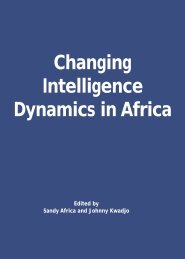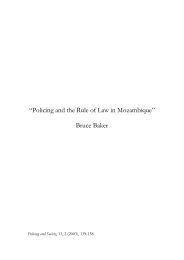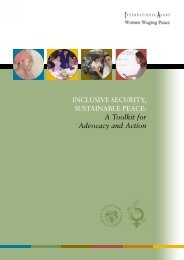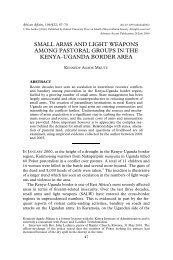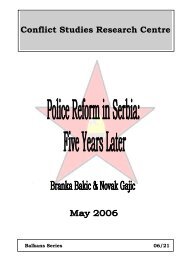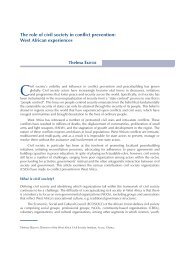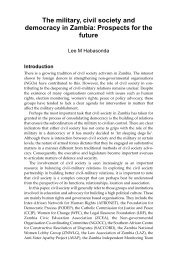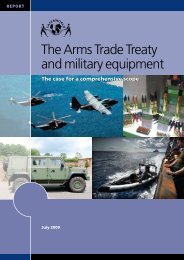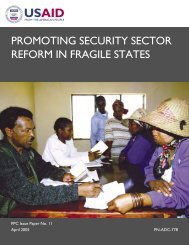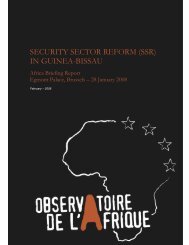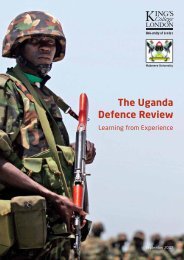AFGHANISTAN'S ELECTION CHALLENGES
AFGHANISTAN'S ELECTION CHALLENGES
AFGHANISTAN'S ELECTION CHALLENGES
Create successful ePaper yourself
Turn your PDF publications into a flip-book with our unique Google optimized e-Paper software.
Afghanistan’s Election Challenges<br />
Crisis Group Asia Report N°171, 24 June 2009 Page 19<br />
ised, similarly had 23 candidates for fifteen seats in<br />
Faryab, sixteen for fifteen seats in Kunduz and ten for<br />
nine seats in Sar-i Pul reflecting internal party divisions.<br />
A local Junbish representative emphasised they<br />
were working to reduce the numbers. 138<br />
Some parties are however showing they learnt from<br />
previous failures. In 2005 Afghan Millat stood 31<br />
candidates for the Nangarhar provincial council in<br />
2005, dividing the vote so far it ended up with no<br />
elected representatives. This time it is putting up four<br />
men and one woman in Nangarhar (twelve nationwide)<br />
as official candidates and is seeking to apportion<br />
support by getting supporters to vote for them according<br />
to district. 139 Jamiat, which has 47 affiliated candidates<br />
nationwide, has none at all in Herat or the west<br />
despite Ismail Khan’s continued influence, indicating,<br />
as in 2005, the presence of “unofficial” candidates,<br />
affiliated with political parties but standing as independents<br />
to escape party discipline, to avoid the<br />
stigma attached to parties because of their role in the<br />
civil war and under Soviet-backed regimes, or because<br />
there is little value in party affiliation in the current<br />
electoral system.<br />
In some provinces such as Bamiyan, all the incumbents<br />
are running again while in others such as Baghlan only<br />
one third are. Several of those who are standing down<br />
spoke of running for the Wolesi Jirga in 2010 instead.<br />
Indeed, the Meshrano Jirga seats from the provincial<br />
councils may also be more contested, given the lack<br />
of authority of provincial councils and worsening security<br />
in some provinces.<br />
2. 26Vetting<br />
Candidates must sign oaths that they meet eligibility<br />
requirements. Other than that, the IEC absolved itself<br />
of monitoring compliance beyond the purely procedural<br />
– such as checking that the required lists of supporters<br />
were in order. 140 This followed months of work to<br />
strengthen exclusions for links to armed groups, including<br />
the interior ministry sending letters in early 2009<br />
to around 100 people it understood might stand for<br />
138 Crisis Group telephone interview, Mohammad Asif Payman,<br />
Junbish official in Faryab, 24 May 2009.<br />
139 Crisis Group interview, Mir Wali Khan, Nangarhar Afghan<br />
Millat official, Jalalabad, 10 February 2009; telephone<br />
interview, 24 May 2009.<br />
140 Article 35 of the Electoral Law (2005). A candidate for the<br />
presidential election must deposit 50,000 afghanis (about<br />
$1000) and the names of 10,000 supporters. The money is<br />
returned if the candidate receives 15 per cent of the total<br />
valid votes. Provincial council candidates deposit 4,000<br />
afghanis (about $80) and 200 supporters’ names, and receive<br />
the money back if they secure 2 per cent of the vote.<br />
provincial councils, reminding them of disarmament<br />
requirements. 141 In April, however, the IEC decided<br />
against pre-emptive checking of nominees’ names<br />
against lists of armed groups before the production of<br />
the preliminary candidate lists. It was argued that the<br />
IEC was “not a security institution and does not have<br />
the capacity to determine [such issues]”. 142 Not one<br />
candidate was removed, even on procedural grounds,<br />
before the release of the preliminary lists, leaving eligibility<br />
solely to be determined by the ECC. 143<br />
In the few days allowed for public submissions, the<br />
ECC received 302 challenges – around 50 about presidential<br />
and vice-presidential candidates and the rest<br />
about provincial council nominees from 31 provinces. 144<br />
This was a substantial drop on the 1,144 challenges<br />
received in 2005 although that involved thousands of<br />
Wolesi Jirga candidates as well. 145 On 9 June the<br />
ECC announced that they had excluded three – minor<br />
– presidential/vice-presidential candidates (Akbar<br />
Bai, Sayed Jafar Hofiani and Ziauddin) and 54 provincial<br />
council candidates. Of those on presidential<br />
slates, there was exclusion for the first time on the<br />
grounds of a candidate having a criminal conviction –<br />
a foreign one. Another was excluded for holding dual<br />
citizenship.<br />
All provincial council candidate exclusions were for<br />
links to armed groups. 146 Determining who is involved<br />
in an armed group was left to the Disarmament<br />
and Reintegration Commission (DRC), which<br />
consists of the ministries of interior and defence, the<br />
National Security Directorate, UNAMA and ISAF.<br />
The DRC was supposed to have revised a list of illegal<br />
armed groups, produced under the Disbandment<br />
of Illegal Armed Groups (DIAG) program, in 2008<br />
and 2009. 147 Efforts had however been continually<br />
141 Crisis Group interview, Western security official, Kabul,<br />
13 May 2009.<br />
142 Crisis Group interview, Zekria Barakzai, deputy chief<br />
electoral officer, 15 May 2009.<br />
143 Before the final lists one more presidential and 90 provincial<br />
council candidates (including 13 females) had volpresidential<br />
untarily withdrawn their names. “Final list for<br />
and provincial council election candidates”, IEC press re-<br />
N°35,<br />
lease, 13 June 2009.<br />
144 ECC press conference, Kabul, 9 June 2009.<br />
145 ECC, Final Report, March 2006, p. 19.<br />
146 ECC press conference, Kabul, 9 June 2009.<br />
147 The “remapping” exercise was initiated by vicepresidential<br />
decree in September 2008. The Disarmament,<br />
Demobilisation and Reintegration (DDR) program, which<br />
was officially completed in 2005, focused on units on the<br />
defence ministry payroll. The follow-on Disbandment of<br />
Illegal Armed Groups (DIAG) program is today largely<br />
moribund. See Crisis Group Asia Briefing Afghani-



